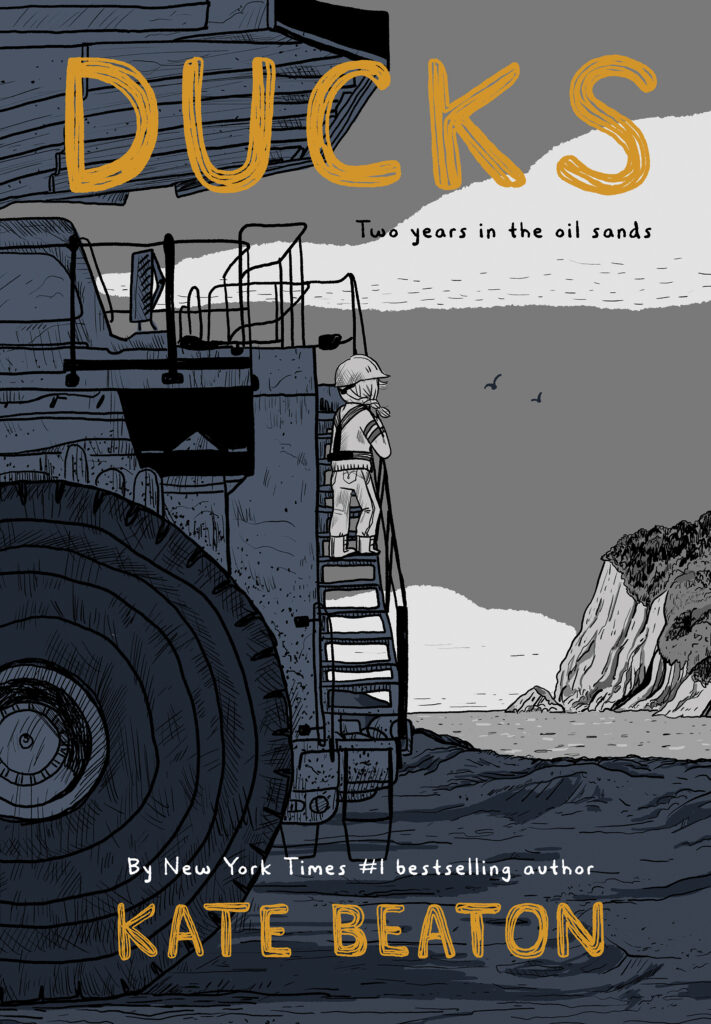
Rating: ⭐⭐⭐⭐
Author: Kate Beaton
Genres: Graphic Novel, Memoir
Pub. Date: Sep. 2022
I’ve been seeing Ducks everywhere since the Goodreads Choice Awards, which really surprised me when I learned it was a graphic novel written by an East Coaster about the oil sands (this type of Canadian lit doesn’t usually go mainstream). I finally got my hands on a library copy of this beast of book, just in time for it to be nominated for Canada Reads!
It is a really interesting book. The storyline is subtle and we spend a lot of time in dull labour camps, but it’s still very compelling. Kate Beaton grew up in Cape Breton and after completing her Bachelor of Arts degree in the early 2000’s, decides to follow the horde of islanders heading west in order to pay off her student loans.
She moves to Fort MacMurray, a notorious place in northern Alberta that’s known for the oil sands, dirty money, questionable environmentalism, and eastern imports in the form of people. People from Fort Mac probably won’t like my assessment because they’re just trying to make a living, but as Kate concludes towards the end of the book, her motivations for being there don’t make her less complicit in the work being done.
Kate is from Cape Breton; even though I’m from Newfoundland, this is definitely a story any Newfoundlander can relate to. Since the collapse of the food fishery in the early 1990’s, watching your family members and friends head west in search of work is something that has touched everyone. I actually applaud Kate for her courage in going out there alone without a job as a 22 year old woman.
However, it’s undeniable that the oil sands weren’t a great place to be female in the early 2000’s. I’m sure the camps and companies have evolved in the past 20 years to become more progressive, but I’m also sure there are many more subtle ways in which they haven’t. I haven’t worked in the oil sands, but I did a brief stint on a heavy construction project in Labrador in 2013 where sexism was very much still present. My experience was nothing like Kate’s, but her experiences were still very relatable.
Most of what Kate tackles in this book is about mental health and loneliness and how this separation from society and detachment from reality creates harmful and sexist work and safety cultures. She explores the prevalence of toxic masculinity, gendered violence, and microaggressions in male dominated work spaces, and the dichotomy of character that can result from extended periods of time in this environment. There were lots of good men on the sites that Kate never interacts with because they politely leave her alone, but there were also a lot of lonely and frustrated men who become divorced from who they are when immersed in camp life.
At least that is how Kate looks at it. More jaded individuals might look at her experience and say that for some men, that ugliness has always been there and that the labour camps just expose it. I don’t know which is true, probably both, but I appreciated Kate’s exploration of this character change. After her experience, it would be easy for her to be jaded and think the worst of men, but she’s still willing to think more critically about mental health and loneliness.
What drove this home for me is the inclusion of so many Newfoundlanders in the story. There are a lot of Newfoundlanders in Fort Mac, so it’s an accurate portrayal. Traditionally, Newfoundlanders are known for their friendliness and willingness to open their homes to strangers. It’s something I’ve always been very proud of, though I have found in the past 10 years since I left Newfoundland, that there is a limit to this friendliness that it’s sometimes only extended to that which is familiar. By which I mean that I think there is still a culture of othering and outsiders.
Because we so often look at what we love with rose coloured glasses, it’s sobering to look at this negative portrayal of so many East Coast men. As Kate says, “the worst part for me about being harassed here isn’t that people say shitty things. It’s when they say them and they sound like me, in the accent that I dropped when I went to University. That they look like my cousins and uncles… that they’re familiar.” It’s not that she’s saying the behaviour is indicative of where the men come from, just that it’s disappointing to realize that the potential exists in those we know and love.
In fact, when Kate gets a call from the Globe and Mail wanting to write about her experience, she decides not to take the interview. She says of the interviewer, “I don’t think people like her believe that the men they know wouldn’t be any different. They don’t think that the loneliness and homesickness and boredom and lack of women around would affect their brother or dad or husband the same way – why would they? They don’t think about it at all. They never have to.”
I did really like this book. I felt some improvements could be made; it’s a bit long and there is a lot of interactions and filler that I thought could have been consolidated, but it paints a very detailed picture of what life was like for Kate and of capturing how microaggressions can wear us down over time. I’m glad it’s been selected for Canada Reads, because I think it’s especially important for Canadians. Great storytelling and imagery!



